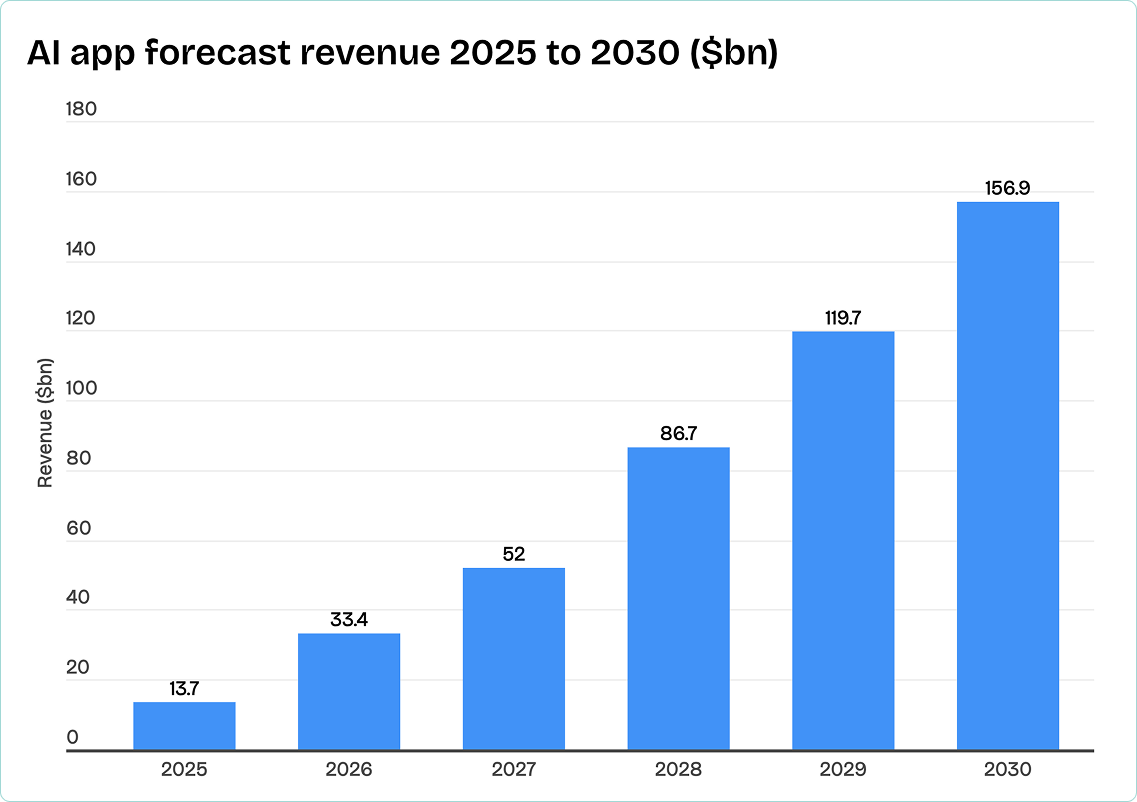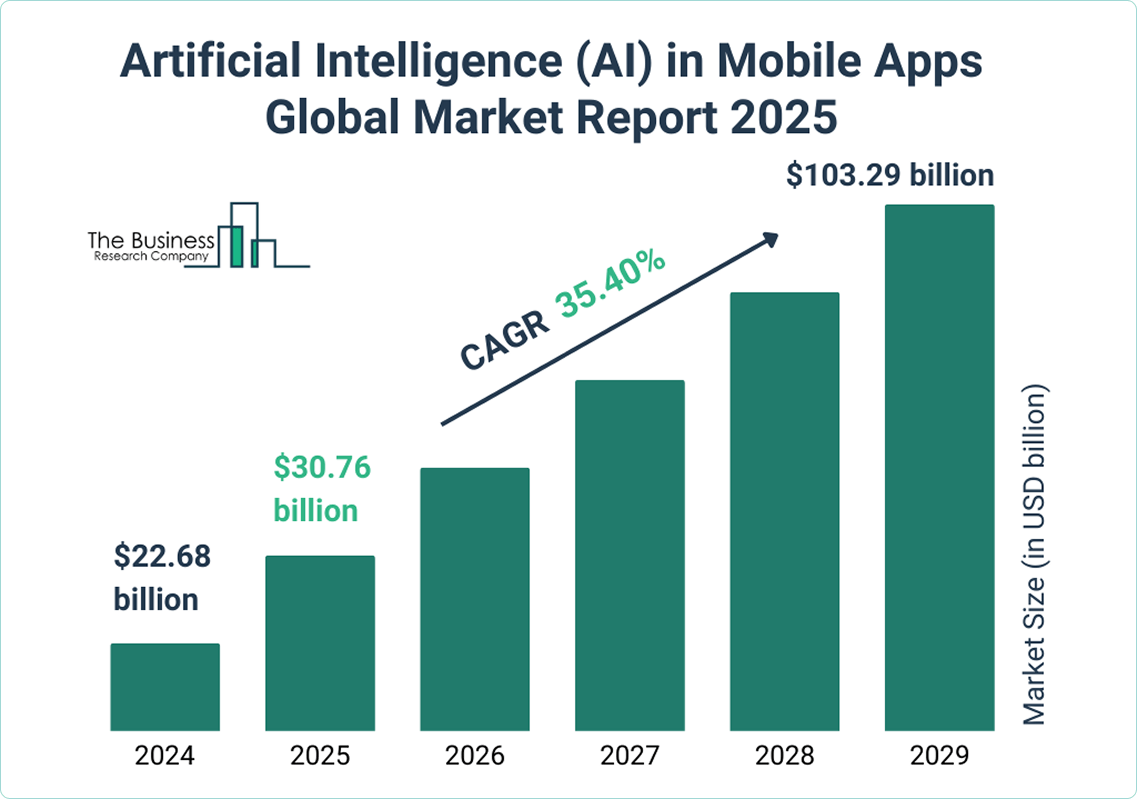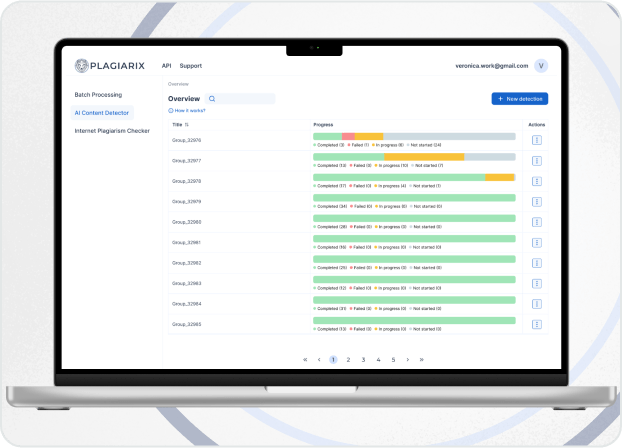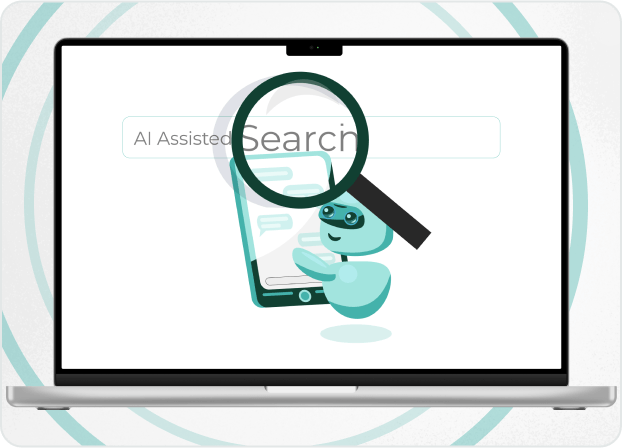
Expert’s Thoughts

"One of the main branches of AI industry development is how AI is implemented into applications, whether desktop, mobile or web. AI-based apps have become desirable for companies all around the world, but many still struggle to launch their own AI-based products.
Leveraging the vast experience of our AI programmers, we prepared the following blogpost on how to build an AI app."
Yuri Svirid, PhD. — CEO Silk Data
Key Insights from AI Apps Industry
First, we should start with a short backstory. In June 2023 McKensey Digital presented a comprehensive report on the economic potential of generative AI . It was a reaction to the rapid growth of the AI industry launched by ChatGPT at the end of 2022.
The report estimated that the generative AI implementation could add the equivalent of 2.6 to 4.4 trillion USD annually across 63 different use cases.
McKensey continues to stand for these numbers in its latest report of January 2025.
Furthermore, the Business of Apps report of May 2025 indicates that the revenue of AI apps at the beginning of 2025 reached almost 14 billion USD worldwide, and the number is expected to grow ten-fold in the next 5 years.

In addition, the report published by a Business Research Company in May 2025 indicates that the market size of AI in mobile applications overcame the point of 30 billion USD, which makes it 35% larger than in 2024 . Furthermore, the growth rate is expected to be at the same level of 35-36% a year, so the market will reach a 100 billion USD mark by 2029 .

The growing need and adoption of AI in both web and mobile application development is unquestionable. Companies from industries like healthcare, retail, finance and media are ready to invest extra budgets into acquiring new AI-based products.
However, a new problem occurs. According to article by McKensey Digital ‘while 92 % of middle and large companies already invest and plan to increase their investments into AI, only 1 % really know how to work with AI tools and consider themselves ‘mature’ enough for AI development’.
Through that, Silk Data prepared a blogpost on how to create your own AI app and leverage the capabilities of AI-based applications. Our goal here is to highlight the main aspects of dealing with AI applications development and demonstrate the business benefits of using AI apps in your business.
Key Aspects of How to Build an AI App

Goal Setting and Planning
Any digital project starts with the identification of its goals. No matter whether you are starting an in-house development or apply to outsourcing company, the task here is to define the pain point the future AI tool will solve. It can be simple customer support automation, text summarization or a full-scale solution with advanced capabilities for predictive analytics and smart recommendations.
In most cases, clear project goals identification influences the type of ai driven app you need and the specifics of an AI app development process.
For example, you need a software for the customer purchase and procurement requests analysis , or your recruiters face problems with processing of candidate’s CVs. Then you may focus on the development of solutions based on natural language processing technologies .
Perhaps, you’d like to get a software that will permanently monitor the performance of your teams and corporate processes and be able to provide flexible smart recommendations with minimal human interference? Then, you should apply to AI agent – AI tool with advanced capabilities of reasoning, analysis, self-learning and self-correction .
You also may require the most explicit tool for personalized customer assistance. So, your choice is an AI-based avatar – solution that combines the capabilities of machine learning and computer vision technologies. This AI avatar can be part of your mobile application.
For example, you can create an avatar that duplicates movie stars or famous musicians and make them AI-reinforced interactive assistants in your video and music streaming app. One more idea is to use AI avatars as shop assistants and support specialists in e-commerce and online retail mobile applications , adding an unmatched personalization capability to your business’s customer support.
In the end, the clear goals identification and even approximate understanding of features required may give you a picture of estimated time and money costs along with the amount and quality of data necessary for AI model training.
The safest way of aligning your needs and expectations with real possibilities is to apply for AI Proof of Concept and MVP development. The first entity will allow to understand whether the project is technically and financially possible or not, while the second shows the product’s alignment with the initial demands and its efficiency and working capacities.

Data Preparation
The second aspect implies working with the initial data necessary for training the AI model implemented into your application. It can be divided into two sub-steps: data gathering and data preparation itself.
Data gathering means that you summon the vital data for a certain period of time. It can be marketing metrics, analyzed and graded student assignments, financial and legal documents, etc . In some cases, proper model training may require tens and even hundreds of thousands of data pieces, while the processing of data gathering and their further processing can take hundreds of working hours. However, there are development ways where the gathering of thousands of documents and statistical metrics is unnecessary.
Silk Data’s AI programmers successfully implemented an approach when the AI-based tool can automatically classify semantically related documents and align its operations with a particular document type. Our AI-based document analysis tool for financial company was relieved from the necessity of dealing with thousands of similar files, as only a few examples were enough for the model to process each document according to its type (account opening/closing request, loan applications, etc.)
In data preparation, specialists analyze the data and verify its quality. For example, they can find data pieces with false entities that don’t align with the formal logic.
For example, in building AI software for agricultural holding with the main purpose of monitoring and analyzing animals’ health conditions, Silk Data’s specialists faced a certain amount of erroneous data. This data referred to the physical conditions of the animals and could cause problems in future AI-based processing. Through that, an additional step of data cleaning was added.

Model Choice and Training
The AI capabilities of your application imply that it will be based on the work of an AI model. So, when the functionality is planned and all the necessary data is gathered, you may get to training of your model.
Note. Gathered data doesn’t mean that you may immediately start loading it into a model. In task-specific tools development, a testing dataset is created, so that the model could immediately process only vital and relevant data.
Here the business also has two choices:
- Developing and training an AI model from scratch.
- Applying ready-to-use solution via popular large language models’ API implementation (like ChatGPT, Claude, etc.).
Each of them has a number of benefits and considerations.
For example, custom LLM provides advanced data security (when you have full control and strict access policy to your training data) which is crucial for financial healthcare or legal organizations and allows to build a solution tailored to your exact business needs.
However, such an approach requires sufficient time and money investments (as many months can be spent on data collection, cleaning, model development and fine-tuning) while building an AI model from scratch implies access to experienced specialists.
Indeed, the time and resources spent on the AI app project depend on numerous factors and the final numbers are the result of thorough and important process of planning and counting.
Here is the approximate breakdown of time and specialists needed for working with a custom AI model:
| Stage | Time spending estimations | Key specialists | Responsibilities |
|---|---|---|---|
| Data Collection | 15-20% | Data Engineers | Gathering of raw datasets (APIs, databases, scraping) |
| Data Cleaning | 20-30% | Data Engineers | Handling missing values, outliers, formatting |
| Data Annotation (required for supervised learning while working with computer vision and NLP development) | 10-15% | Data Annotators | Labeling data |
| Model Development | 20-25% | ML Engineers Data Scientists | Selecting algorithms and training prototypes |
| Model Evaluation | 10-15% | Data Scientists | Testing of AI model performance and results interpretation and analysis |
| Deployment | 10-15% | ML Engineers DevOps Engineers | Integrating AI model into production |
This breakdown is just an example of AI model training and deployment structure, as some of the steps can be removed or added. For example, you can have an additional 5-10% of time added to the above-mentioned estimates for a problem definition pre-stage . Here is where success metrics and initial goals are defined, and it is typically the responsibility of project managers and senior ML and Data engineers .
In addition, many AI development companies, especially small ones, tend to overlap some stages and specialists' responsibilities. For example, far from all of them have data annotators and their work can be divided between other team members.
At the same time, applying to ready-to-use LLM APIs means quicker delivery to the market, lower initial costs (thanks to 'pay-as-you-go' pricing) and almost full absence of maintenance issues. The main disadvantage, however, is that your app will fully depend on your provider’s performance, so the risk of downfalls and model hallucinations increases.
In addition, the costs of model operations may also ongoingly increase with the expanded traffic of requests.
We have thoroughly discovered the pros and cons of ChatGPT’s and other popular LLMs API usage in one of our blogposts . What is possible to add is that the right choice depends only on your needs and the resources available. Silk Data still demonstrates vast expertise in both local LLMs deployment and ChatGPT integration for business needs.
A short comparison of the above-mentioned approaches is presented in the following table.
| Criteria | Custom LLM | LLM API Integration |
|---|---|---|
| Cost | High initial costs, lower in long-term | Low initial costs, may increase in the future |
| Time | Months | Weeks, sometimes mere days |
| Control | Full control over data, logic, performance and updates | Limited, depends on the API provider |
Both approaches require training the model by loading it with a prepared dataset, but applying to LLMs’ API can save lots of time.
It happens because all popular LLMs like ChatGPT, Gemini, Claude or DeepSeek are trained on such massive datasets that their almost immediate usage is possible among a wide range of industries and tasks.
Furthermore, right now the industry is demonstrating a rapid shift from data preparation and training to RAG-based AI development . It’s an approach that allows to bring additional, the most up-to-date context to the LLM’s response, as RAG framework searches through external knowledge base while the model processes the user query.
Using RAG, AI programmers get rid of the necessity of dealing with large training datasets (though they’re still necessary in some cases).

AI Model Integration
The specifics of your project and the approach that you chose for developing and training the AI model also influence the process of its integration.
For example, if you work on the solution based on custom AI model, you’ll have to get through several steps:
- Building an API wrapper. Create a ‘bridge’ between the AI model and users’ inputs. In doing so, you may base on tools like Flask and Fast API (Python frameworks used to build APIs for serving AI models in web applications).
- Containerizing the model for deployment. Packaging the AI model, its dependencies and API into a lightweight, portable unit that consistently functions on any device and across any environment. You can use Docker for containerizing itself, while the ‘container’ is pushed further to AWS SageMaker or Kubernetes (special managing and orchestrational systems used for containers deployment).
- Optimizing for hardware and specific cases. The process of optimizing AI models for resource-constrained devices (for example, mobile phones) and cases when speed is crucial (for example, live translation or filtering).
The process can be rather time-consuming and requires a lot of effort, especially in DevOps and MLOps expertise.
On the contrary, usage of pre-trained LLM APIs implies no standard AI model deployment. You should only call the API of your provider, whether it is OpenAI, Anthropic, Google or any other, via special HTTP requests. Then the task comes down to handling the system’s authentication and rate limits along with managing operational costs.

Performance Monitoring and Fine-Tuning
The last key aspect of creating an AI-driven app lies in post-launch operations. The task here is to track the performance of your applications along with the accuracy, response time and downfalls of the implemented AI model.
In doing so, AI teams work with tools like Prometheus (an open-source database that collects and stores vital metrics, for example, API response times and error rates) and Grafana (a visualization tool that transforms Prometheus analytics data into dashboards).
Such performance tracking is a basis for further updates and AI model fine-tuning, when you try to improve the app’s operationing via fresh data uploading or correcting the AI responses.
AI Applications Business Benefits

Repetitive Tasks Automation
The first factor that is crucial for companies looking for AI-based application for their corporate needs.
According to ‘Future of Professionals’ report made by Thomson Reuters company in July 2024, AI tools saved marketers, SEO specialists, sales managers and customer service specialists about 2.5 hours per day. Furthermore, all the other specialists (programmers, project managers and companies' executives) report about 4 hours saved every week, and the number is expected to reach 12 hours by 2029.
 46 hours week worked in an avarage week 46 hours week worked in an avarage week | 54% feel they do not have enoughtime to achieve everything they would like to in their role | With the predicated pace of AI adoption, respondents expect to free up 4 hours a week in the next year | With the predicated pace of AI adoption, respondents expect to free up 8 hours a week in three years time | With the predicated pace of AI adoption, respondents expect to free up 12 hours a week in five years time |
In most cases such outstanding results are achieved via automation of monotonous operations and repetitive low-level tasks. For example, Silk Data developed an AI-based solution that allows to fully automate the process of legal documents analysis . The tool processes the document, identifies the key information, classifies the document and summarizes it, visually highlighting the key points. As a result, the user spends mere minutes on tasks that could take up many hours.

Enhanced User Experience
By leveraging AI, businesses can create highly personalized and intuitive interactions that cater to individual user preferences. AI-driven chatbots, for instance, offer instant and accurate responses to customer inquiries, while recommendation systems analyze user behavior to suggest relevant products or content, fostering deeper engagement and loyalty. These capabilities ensure a seamless and satisfying experience that keeps users coming back.

Advanced Decision-Making
When it comes to decision-making, AI empowers businesses with data-driven insights that go beyond human analysis. Machine learning algorithms process vast datasets in real time, uncovering hidden patterns and correlations that inform strategic choices. Whether optimizing supply chains, identifying market trends or assessing risks, custom AI applications can provide executives with actionable intelligence that enhances accuracy and reduces uncertainty. This leads to smarter investments, improved operational efficiency and a stronger competitive position in the market.
We discovered the nature and key benefits of AI usage in decision-making processes in one of our blogposts. AI’s capabilities - from predictive analytics and smart recommendations to fully automated decision-making - truly revolutionize industries by enhancing efficiency, personalization and risk management.

Contemporary Predictive Analytics
Predictive analytics, powered by AI, revolutionizes how businesses anticipate future outcomes. By analyzing historical and real-time data, AI models forecast demand fluctuations, customer behavior and potential system failures before they occur. Retailers use these insights to manage inventory more effectively, while financial institutions predict credit risks with greater precision. Predictive maintenance in manufacturing minimizes downtime by identifying equipment issues before they escalate, saving costs and improving productivity.
Conclusion
The rapid evolution of AI applications presents an unparalleled opportunity for businesses to transform operations, enhance customer experiences and drive innovation. However, the journey from idea to deployment requires careful planning, technical expertise and a clear understanding of business objectives.
Whether opting for a custom-built AI model or leveraging pre-trained APIs, businesses must align their approach with their specific needs, budget and long-term strategy. For businesses ready to embark on this transformative journey, partnering with experienced AI developers ensures a smooth transition from concept to execution. At Silk Data, we combine technical expertise with industry knowledge to deliver tailored AI solutions that drive measurable results.
Ready to build your AI application? Contact our team today and turn your vision into reality.
Our Solutions
We work in various directions, providing a vast range of IT and AI services. Moreover, working on any task, we’re able to provide you with products of different complexity and elaboration, including proof of concept, minimum viable product, or full product development.
























